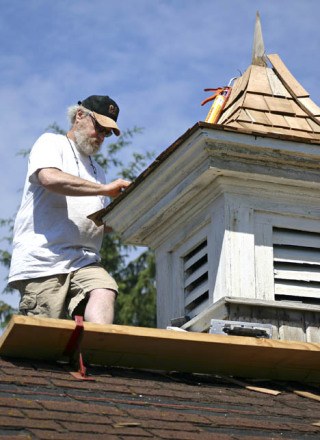Restoration began today on one of Washington’s oldest county jails.
Dana Owens restored the cupola of the 1895 San Juan County Jail, located on the grounds of the San Juan Historical Museum.
Bailer Hill Construction and Local Islands Roofing are doing the main roof. The entire roof of the old jail, which houses public exhibits related its history, is expected to be completed in time for the Fourth of July Pig War Picnic on the museum grounds.
It’s the first of a series of restoration projects planned at the museum. The San Juan Historical Society Board of Directors is expected to begin negotiating the sale of a historical preservation easement to the Land Bank in early July. Proponents say funds from the sale will help pay for restoration of the buildings, keep the last remnant of the once expansive King Farm available for public use, and make available a site for relocation of a heritage building threatened with demolition.
Buildings on the museum grounds include the farmhouse, carriage house, milk house and a stone building used as a root cellar for the storage of food. The building were built by James F. King in 1894; the farm was 445 acres in size.
The Pioneer Cabin was built by Edward Scribner in 1891 at Mitchell Bay; it was moved to the museum grounds in 1988.
The county jail was built in 1895 and was used until 1971, when it was declared to be “the worst county jail in the state of Washington.” It was moved to the museum in 1988.
The barn was constructed by the museum in 1980 to house exhibits. It is currently in the middle of an expansion and restoration project. It was built on the site of the original King barn, which was destroyed by fire.
The Etta Egeland Resource Center houses the museum’s rotating exhibits, research library, museum offices and storage.



